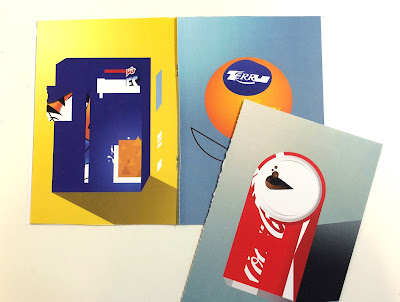In October it was hard to imagine that COP2 could go as bad as it had in Year 4, but a lot of it has.It certainly hasn't been a whole lot better that's for sure.The Roland Barthes study task summed up the majority of the academic side of the module: "I don't know what I'm doing, this makes NO sense and never will".
It's hard to find much to say that differs from my COP1 evaluations.I encountered the same basic issues from minute one. I found the few things I'm really interested in weren't really worthy of having an essay written about them, no matter how hard i tried to shoehorn them into my research. My essay question seemed to change on a weekly basis, and for a long time was way too broad to keep within the 3000 word limit. Even though clearly struggling hard with getting going, or being able to focus on a particular subject i was hesitant in seeking help from student support. It got to the stage when i finally did seek out support and i wish i'd done it sooner as i found the sessions really useful in helping me to make my essay question more focused. Also was good to have someone look over my word structuring, referencing and quotations for the purposes of submitting. Going forward i'll sign up for support sessions from the 'off' on COP3, as I'm still a huge essay writing amateur, and most of the time it feels like i don't know what I'm doing. The final essay moved totally away from being about art and was more about history, which i hadn't planned for and won't be something i'll be repeating next year, as it made finding actual history books in the library, as opposed to art history books, quite hard to find and reference, and i had to rely largely on articles found online - but it possibly lead to more interesting results regarding the practical response.
My strengths were always going to be in producing the publication - even though we were always told its not about the final result, but more about the idea. But as my written response will more than likely drag my marks down i needed to make the maximum effort to produce a publication that not only looked good but had well thought out concept, something that I'm not always guilty of doing. I was always conscious of not simply illustrating my essay, but i think possibly i might have gone too far in the other direction. The publication does have a link to contents of my essay, but whether anyone (apart from myself) could find those links is another matter.
When i did get up & running and enthusiastic about my publication ideas i found i really became inspired by the thorough research i was doing. The research,as with the essay was a look entirely into the past, so you could say that that's a connection between the written and practical responses.However, the delays in getting up and running with my essay (which resulted in me missing the draft essay hand-in deadline) lead to delays in me getting cracking with the practical response, so by the time i was really getting stuck into it and was coming up with ideas quite freely, it was time to wrap the project up and submit. Which was massively frustrating, but again, i could see that happening from the beginning, which makes it even more frustrating.
So apart from the last couple of weeks working on the publication i can't I've enjoyed any of the past 7 months struggling to gets things done on this module. Much like in Level4 I don't feel I'm learning a whole lot to benefit me beyond the degree, no matter how much the tutors tell us it will, and now the wheels of COP3 are already in motion, with the twitching body of COP2 still warm, I'm facing the thought of writing a 9000 word dissertation about 'anything' (as long as i can keep it art related) with some considerable trepidation. Which is a shame as, after speaking to a few of the year6 students, they've said what a great module it is in the 3rd year.Some even said it was the best module! I couldn't be any further from thinking the same, although i appreciate it will be a great opportunity to make some impressive looking work, with some real thought behind it, backed up and connected somehow to my written work. I know for one thing; I'm not going to be able to leave it all until so late in the day to complete that one.
But the struggle to find something I want to write about has already begun and is very real and terrifying.









































